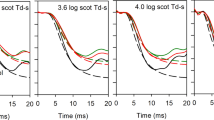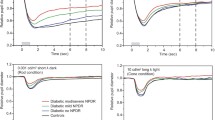Abstract
Purpose
To define the relationship between abnormalities in the activation phase of cone phototransduction and the oscillatory potentials (OPs) of the light-adapted electroretinogram in diabetics who have mild or no retinopathy.
Methods
Subjects included 20 non-diabetic controls and 40 type-2 diabetics (20 had no clinically apparent diabetic retinopathy [NDR] and 20 had mild nonproliferative DR). Single flash responses for a series of stimulus retinal illuminances were measured under light-adapted conditions using conventional techniques. The a-waves of the responses were fit with a delayed Gaussian model to derive Rmp3 (maximum amplitude of the massed photoreceptor response) and S (phototransduction sensitivity). OPs were extracted from the responses by conventional band-pass filtering.
Results
Analysis of variance (ANVOA) indicated that both diabetic groups had significant OP amplitude and S reductions compared to the controls, whereas Rmp3 did not differ significantly among the groups. Although log OP amplitude and log Rmp3 were significantly correlated for the control subjects for each flash retinal illuminance (all r > 0.49, p < 0.03), log OP amplitude and log Rmp3 were not correlated for either diabetic group for any flash retinal illuminance (all r ≤ 0.36, p ≥ 0.13). Log OP amplitude and log S were generally not correlated significantly for the control or diabetic groups.
Conclusion
OP amplitude losses do not appear to be related to reduced cone sensitivity in early-stage diabetic retinopathy. This suggests that diabetes may separately affect cone function, as evidenced by cone phototransduction sensitivity losses, and inner-retina function, as evidenced by OP amplitude losses.






Similar content being viewed by others
References
Adams AJ, Bearse MA Jr (2012) Retinal neuropathy precedes vasculopathy in diabetes: a function-based opportunity for early treatment intervention? Clin Exp Optom 95(3):256–265. https://doi.org/10.1111/j.1444-0938.2012.00733.x
Lynch SK, Abramoff MD (2017) Diabetic retinopathy is a neurodegenerative disorder. Vis Res 139:101–107. https://doi.org/10.1016/j.visres.2017.03.003
Holopigian K, Seiple W, Lorenzo M, Carr R (1992) A comparison of photopic and scotopic electroretinographic changes in early diabetic retinopathy. Invest Ophthalmol Vis Sci 33(10):2773–2780
King-Smith PE, Loffing DH, Jones R (1986) Rod and cone ERGs and their oscillatory potentials. Invest Ophthalmol Vis Sci 27(2):270–273
Peachey NS, Alexander KR, Fishman GA (1987) Rod and cone system contributions to oscillatory potentials: an explanation for the conditioning flash effect. Vis Res 27(6):859–866
Lachapelle P, Rousseau S, McKerral M, Benoit J, Polomeno RC, Koenekoop RK, Little JM (1998) Evidence supportive of a functional discrimination between photopic oscillatory potentials as revealed with cone and rod mediated retinopathies. Doc Ophthalmol 95(1):35–54
Rousseau S, Lachapelle P (1999) The electroretinogram recorded at the onset of dark-adaptation: understanding the origin of the scotopic oscillatory potentials. Doc Ophthalmol 99(2):135–150
Wachtmeister L (1998) Oscillatory potentials in the retina: what do they reveal. Prog Retin Eye Res 17(4):485–521
Wachtmeister L, Dowling JE (1978) The oscillatory potentials of the mudpuppy retina. Invest Ophthalmol Vis Sci 17(12):1176–1188
Tzekov R, Arden GB (1999) The electroretinogram in diabetic retinopathy. Surv Ophthalmol 44(1):53–60
Bearse MA Jr, Adams AJ, Han Y, Schneck ME, Ng J, Bronson-Castain K, Barez S (2006) A multifocal electroretinogram model predicting the development of diabetic retinopathy. Prog Retin Eye Res 25(5):425–448. https://doi.org/10.1016/j.preteyeres.2006.07.001
Holopigian K, Greenstein VC, Seiple W, Hood DC, Carr RE (1997) Evidence for photoreceptor changes in patients with diabetic retinopathy. Invest Ophthalmol Vis Sci 38(11):2355–2365
McAnany JJ, Chen YF, Liu K, Park JC (2019) Nonlinearities in the flicker electroretinogram: A tool for studying retinal dysfunction applied to early-stage diabetic retinopathy. Vision Res 161:1–11. https://doi.org/10.1016/j.visres.2019.05.005
McAnany JJ, Park JC (2018) Temporal frequency abnormalities in early-stage diabetic retinopathy assessed by electroretinography. Invest Ophthalmol Vis Sci 59(12):4871–4879. https://doi.org/10.1167/iovs.18-25199
McAnany JJ, Park JC (2019) Cone photoreceptor dysfunction in early-stage diabetic retinopathy: association between the activation phase of cone phototransduction and the flicker electroretinogram. Invest Ophthalmol Vis Sci 60(1):64–72. https://doi.org/10.1167/iovs.18-25946
McAnany JJ, Park JC, Chau FY, Leiderman YI, Lim JI, Blair NP (2018) Amplitude loss of the high-frequency flicker electroretinogram in early diabetic retinopathy. Retina. https://doi.org/10.1097/IAE.0000000000002262
Park JC, Chau FY, Lim JI, McAnany JJ (2019) Electrophysiological and pupillometric measures of inner retina function in nonproliferative diabetic retinopathy. Doc Ophthalmol. https://doi.org/10.1007/s10633-019-09699-2
Hood DC, Birch DG (1994) Rod phototransduction in retinitis pigmentosa: estimation and interpretation of parameters derived from the rod a-wave. Invest Ophthalmol Vis Sci 35(7):2948–2961
Hood DC, Birch DG (1995) Phototransduction in human cones measured using the alpha-wave of the ERG. Vision Res 35(20):2801–2810
Yoshida A, Kojima M, Ogasawara H, Ishiko S (1991) Oscillatory potentials and permeability of the blood-retinal barrier in noninsulin-dependent diabetic patients without retinopathy. Ophthalmology 98(8):1266–1271
Zaharia M, Olivier P, Lafond G, Blondeau P, Brunette JR (1987) Lobular delayed choroidal perfusion as an early angiographic sign of diabetic retinopathy: a preliminary report. Can J Ophthalmol 22(5):257–261
Bresnick GH, Palta M (1987) Oscillatory potential amplitudes. Relation to severity of diabetic retinopathy. Arch Ophthalmol 105 (7):929–933
Brunette JR, Lafond G (1983) Electroretinographic evaluation of diabetic retinopathy: sensitivity of amplitude and time of response. Can J Ophthalmol 18(6):285–289
Wanger P, Persson HE (1985) Early diagnosis of retinal changes in diabetes: a comparison between electroretinography and retinal biomicroscopy. Acta Ophthalmol (Copenh) 63(6):716–720
Gjotterberg M (1974) The electroretinogram in diabetic retinopathy. A clinical study and a critical survey. Acta Ophthalmol (Copenh) 52 (4):521–533
Davis MD, Fisher MR, Gangnon RE, Barton F, Aiello LM, Chew EY, Ferris FL 3rd, Knatterud GL (1998) Risk factors for high-risk proliferative diabetic retinopathy and severe visual loss: Early Treatment Diabetic Retinopathy Study Report #18. Invest Ophthalmol Vis Sci 39(2):233–252
Alexander KR, Rajagopalan AS, Raghuram A, Fishman GA (2006) Activation phase of cone phototransduction and the flicker electroretinogram in retinitis pigmentosa. Vision Res 46(17):2773–2785. https://doi.org/10.1016/j.visres.2006.01.007
Khani-Oskouee K, Sieving PA (1991) A digital band-pass filter for electrophysiology recording systems. In: Heckenlively J, Arden G (eds) Principles and Practice of Clinical Electrophysiology of Vision. Mosby Year Book, St Louis, pp 205–210
Rufiange M, Dumont M, Lachapelle P (2005) Modulation of the human photopic ERG luminance-response function with the use of chromatic stimuli. Vision Res 45(17):2321–2330. https://doi.org/10.1016/j.visres.2005.02.010
Chen H, Zhang M, Huang S, Wu D (2008) The photopic negative response of flash ERG in nonproliferative diabetic retinopathy. Doc Ophthalmol 117(2):129–135. https://doi.org/10.1007/s10633-008-9114-0
Kizawa J, Machida S, Kobayashi T, Gotoh Y, Kurosaka D (2006) Changes of oscillatory potentials and photopic negative response in patients with early diabetic retinopathy. Jpn J Ophthalmol 50(4):367–373. https://doi.org/10.1007/s10384-006-0326-0
Frishman L, Sustar M, Kremers J, McAnany JJ, Sarossy M, Tzekov R, Viswanathan S (2018) ISCEV extended protocol for the photopic negative response (PhNR) of the full-field electroretinogram. Doc Ophthalmol 136(3):207–211. https://doi.org/10.1007/s10633-018-9638-x
Hood DC, Birch DG (1996) Assessing abnormal rod photoreceptor activity with the a-wave of the electroretinogram: applications and methods. Doc Ophthalmol 92(4):253–267
McCulloch DL, Marmor MF, Brigell MG, Hamilton R, Holder GE, Tzekov R, Bach M (2015) ISCEV Standard for full-field clinical electroretinography (2015 update). Doc Ophthalmol 130(1):1–12. https://doi.org/10.1007/s10633-014-9473-7
Lachapelle P, Benoit J, Blain L, Guite P, Roy MS (1990) The oscillatory potentials in response to stimuli of photopic intensities delivered in dark-adaptation: an explanation for the conditioning flash effect. Vision Res 30(4):503–513
Li X, Sun X, Hu Y, Huang J, Zhang H (1992) Electroretinographic oscillatory potentials in diabetic retinopathy. An analysis in the domains of time and frequency. Doc Ophthalmol 81 (2):173–179
Robson JG, Saszik SM, Ahmed J, Frishman LJ (2003) Rod and cone contributions to the a-wave of the electroretinogram of the macaque. J Physiol 547(Pt 2):509–530. https://doi.org/10.1113/jphysiol.2002.030304
Paupoo AA, Mahroo OA, Friedburg C, Lamb TD (2000) Human cone photoreceptor responses measured by the electroretinogram [correction of electoretinogram] a-wave during and after exposure to intense illumination. J Physiol 529(Pt 2):469–482. https://doi.org/10.1111/j.1469-7793.2000.00469.x
Bush RA, Sieving PA (1994) A proximal retinal component in the primate photopic ERG a-wave. Invest Ophthalmol Vis Sci 35(2):635–645
Acknowledgements
National Institutes of Health research Grants R01EY026004 (JM), P30EY001792 (Core Grant), an unrestricted departmental grant and a Dolly Green Scholar award (JM) from Research to Prevent Blindness.
Funding
This study was funded by National Institutes of Health research Grants R01EY026004 (JJM), P30EY001792 (Core Grant), an unrestricted departmental grant and a Dolly Green Scholar award (JJM) from Research to Prevent Blindness.
Author information
Authors and Affiliations
Corresponding author
Ethics declarations
Conflict of interest
All authors declare that there are no conflicts of interest.
Ethical approval
All procedures performed in studies involving human participants were in accordance with the ethical standards of the institutional and/or national research committee and with the 1964 Helsinki declaration and its later amendments or comparable ethical standards.
Statement on the welfare of animals
This article does not contain any studies with animals performed by any of the authors.
Informed consent
Informed consent was obtained from all individual participants included in the study.
Additional information
Publisher's Note
Springer Nature remains neutral with regard to jurisdictional claims in published maps and institutional affiliations.
Electronic supplementary material
Below is the link to the electronic supplementary material.
Rights and permissions
About this article
Cite this article
McAnany, J.J., Liu, K. & Park, J.C. Electrophysiological measures of dysfunction in early-stage diabetic retinopathy: No correlation between cone phototransduction and oscillatory potential abnormalities. Doc Ophthalmol 140, 31–42 (2020). https://doi.org/10.1007/s10633-019-09718-2
Received:
Revised:
Accepted:
Published:
Issue Date:
DOI: https://doi.org/10.1007/s10633-019-09718-2




